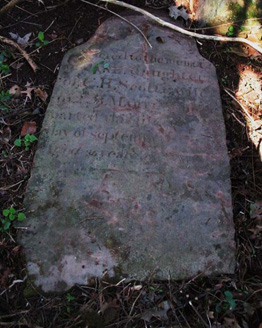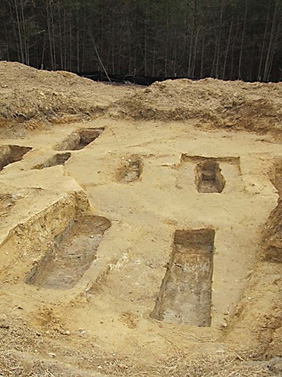
|
| Vol. 22, No. 5 |
September, 30 2014 |
|
|
New Laws in Virginia Bring Change to Procedures for the Removal and Reinterment of Human
Remains from Abandoned Cemeteries
|
The landscape of Virginia includes thousands of abandoned historic cemeteries dating from the 17th century foundation of the colony through the first half of the 20th century, when the practice of burying the deceased on home farms and in small churchyard cemeteries remained common. According to 1989 survey by the Virginia Department of Historic Resources (DHR), at least 2000 such cemeteries exist in Virginia. Lacking obvious identifying elements, such as engraved headstones and well-marked boundaries, and often overgrown with dense vegetation - many of these cemeteries essentially disappear from the landscape.
Therefore, the presence or discovery of an abandoned cemetery on a property slated for development is not unusual, although it is possible in most cases for developers to avoid these sites, once the cemetery boundaries have been archeologically determined (by conducting a cemetery delineation), survey located, and added to development site plans. Disinterment and relocation of an abandoned cemetery is rarely needed, however, it can become necessary due to its particular
location on a site or its discovery late in the development process. Thunderbird Archeology, a division of Wetland Studies and Solutions, Inc., has assisted public and private clients in Virginia with the identification and boundary delineation of cemeteries, and with the removal and reinterment of remains from abandoned grave sites. |
| |
 |
Historic Grave Marker at an Abandoned Cemetery in Prince William County, Virginia
|
|
| |
| Cemetery protection laws in the Code of Virginia prohibit willful destruction of grave sites or disturbance of human remains without approval. Disinterment of human burials may proceed under a court order for the removal of graves, a permit for the archeological recovery of human remains issued by the DHR, or with a permit issued by the local health department. This latter permit, intended for disinterment, transport and reinterment of recent bodies to and from active cemeteries has been used as an alternative to the court order and the archeological permit processes. The health department permit does not require any public notification or standards for the method of removal. |
| |
| Recently amended and reenacted Virginia Code (§§ 57-36 and 57-38.1) requires local governments, “any county, city, or town,” to consider avoidance of adverse impacts to abandoned cemeteries on properties that are acquired by and intended to be developed by the local government prior to completion of development plans. Furthermore, the local governments are required to “engage in active public notice and participation regarding efforts to avoid adverse impacts to the graveyard or to remove the remains interred in such graveyard to an alternative repository“ and “make a good faith effort to identify and contact living descendants of the persons buried in the graveyard.” Public notification efforts must include at least one notice published in a locally circulating newspaper, as required in previous legislation. Additionally, under the new law, notice must be posted at the site of the graveyard, and at
least one public meeting must be held. Consultation with any local historic preservation commission and historical and genealogical societies is also required. |
| |
| The new law also requires that local governments must notify the DHR upon acquiring property upon which is located “an abandoned cemetery or gravesite of Virginians held as slaves at the time of their deaths.” |
| |
| A private landowner that intends to relocate human burials may, as previously noted, proceed under the DHR archeological permit, a health department permit (in some cases) or a court order. Regarding the latter, a landowner may petition the circuit court to relocate “an abandoned family graveyard” in which no body has been interred for twenty-five years, after ensuring that there is “no reservation of rights in such graveyard, or that the beneficiaries of any reservations of rights desire to waive such rights.” The newly amended law (57-38.1) requires additional public notifications by private landowners involved in the disinterment of burials. The landowner must “undertake active, good faith efforts to locate interested parties including, at a minimum, publication of at least one notice in a local newspaper of general circulation, notice posted at the site of the graveyard,
and notice to and consultation with any historic preservation or other such commission, as well as area
historical and genealogical societies.” Under the new law, the landowner is also encouraged to post “notice on the Internet, including appropriate websites and through the use of social media, and to consult with the DHR. The law also encourages the court to consult with DHR regarding the historical significance of the cemetery. |
| |
 |
Grave Sites Disinterred by Thunderbird Archeology
|
|
| |
| Currently, the DHR is working to revise its regulations relevant to the permit for the archeological recovery of human remains, in accordance with the amended Code of Virginia. More information is available here. |
| |
|
|

For more information about this article or on the archeological treatment of cemeteries, contact: Boyd Sipe, Manager of Thunderbird Archeology, or
John Mullen, Principal Archeologist of Thunderbird Archeology
|
|
|
 |
|
|